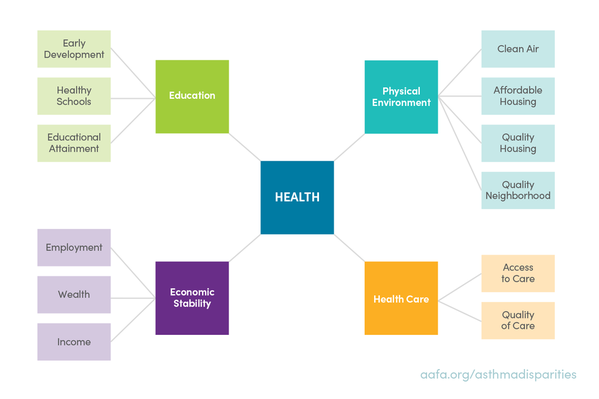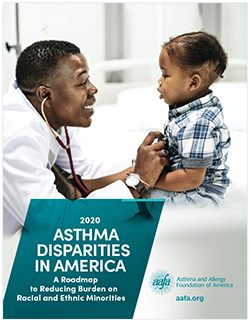Black, Hispanic and American Indian/Alaska Native people have the highest rates of asthma, hospital visits and asthma-related deaths. This has not changed since we first reported on it in 2005. It’s time to take bold steps to reduce disparities in asthma.
Asthma Disparities in America Report
Today, the Asthma and Allergy Foundation of America (AAFA) released its Asthma Disparities in America report. This report looks at how asthma affects Black, Hispanic and American Indian/Alaska Native groups in the United States.
Although health care quality has generally improved for many people in recent years, racial inequities in asthma are still grim. Social and structural disadvantages are the biggest reasons for differences in asthma rates and outcomes for certain racial and ethnic populations.
 In the U.S., big differences exist in asthma based on race and ethnicity. Black, Hispanic, and Indigenous Americans have the highest rates of asthma, asthma-related ER visits and deaths. https://ctt.ec/E8dk1+ via @AAFANational
In the U.S., big differences exist in asthma based on race and ethnicity. Black, Hispanic, and Indigenous Americans have the highest rates of asthma, asthma-related ER visits and deaths. https://ctt.ec/E8dk1+ via @AAFANational
This report is a call to action to fix the social inequalities caused by structural racism that affect at-risk people with asthma and their families.
What Is a “Disparity”?
The word “disparity” means a “great difference.” In health, if a condition – like asthma – affects one group of people differently than another group, it is called a “health disparity.” Many factors can affect health disparities. These include race, ethnicity, age, gender, where you live, disability and citizenship. Low-income groups, women, children, older adults, and people in rural and tribal areas are at the greatest risk for poor health outcomes.
Health in All Policies
To address the social and structural disadvantages causing asthma disparities, we have to rethink our institutional systems and public policies. At AAFA, we believe that education, economic status, environment and health care all impact your health. Because of this, we advocate for policies and changes that will improve asthma outcomes. Policies only related to health care are not enough.
For example, policies that address the climate crisis can reduce air pollution. This can result in cleaner air, which will lower asthma rates and episodes. Our Asthma Disparities in America report outlines 69 various strategies to reduce asthma disparities.

Next Steps
One in 10 people die every day from asthma. And that is 10 too many. AAFA’s mission is to save lives and reduce the burden of disease for people with asthma and allergies through support, advocacy, education and research. Improving asthma care for Black, Hispanic and Indigenous Americans improves asthma care for everyone.
As part of our commitment to racial justice and to reduce health disparities, AAFA and our partners will:
- Gather a group of like-minded people, organizations and partners to prioritize how we tackle asthma disparities together
- Work with Congress, state asthma programs, researchers, health care providers and communities to reduce asthma disparities
- Engage patient advisors to guide us in our programs, research, advocacy, support and education efforts
For more information, read the Asthma Disparities in America report or download it as a PDF. You can also share the report with your community leaders, health care providers and law makers.
This report is made possible by support from AstraZeneca, Genentech, Novartis, PhRMA and Sanofi Genzyme and Regeneron.
How Can You Help Reduce Asthma Disparities?
The only way we can reduce asthma disparities is if we all work together. Everyone – from people with asthma to policy makers and the health care industry – can be a part of building programs that make a lasting difference for people, families and communities impacted by asthma.
Sign up for AAFA’s community to stay up to date about the following opportunities to get involved:
- Advocate for people affected by asthma disparities
- Participate in patient-centered research and clinical trials
- Join our Patient and Family Advisory Council
You can also donate to support AAFA’s mission to create real and lasting change.



Comments (0)